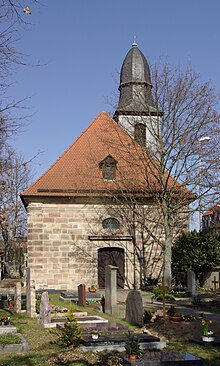Neustädter Friedhofskirche (Erlangen)
The Evangelical Lutheran Neustädter Friedhofskirche on the Neustädter Friedhof in Erlangen is a late Baroque hall building that was built between 1783 and 1787.
history
Since the Neustädter Friedhof, opened in 1703, did not originally have a church, the services for the deceased had to be held first in the Sophienkirche and later in the Neustädter Kirche , each at a considerable distance from the cemetery. Since pastors and mourners could not shelter anywhere in the cemetery when the weather was bad, Hofrat Johann Gottfried Groß had a roof built over his family's grave. The first design for a cemetery church by master bricklayer Georg Christoph Brückner was made in the same year . However, the construction only took place - after the financing through generous donations from influential personalities, a collection among the community members and a grant from the Bayreuth margrave - in the years 1783 to 1787 by the carpenters Johann Paulus Sack and Georg Conrad Thaler as well as the master mason Johann Jakob , Johann Paulus and Georg Christoph Fiedler.
In 1827, the roof turret, financed by the benefactress Anna Margarete Stock, was placed over the main portal on the east side . It had to be replaced in 1928 after a lightning strike. A bell also donated by Stock fell victim to the Second World War . The sacristy on the north side was added in 1848/49. In the 20th century, three major renovations were carried out in 1908/09, 1961/62 and 1988/89.
description
The late baroque, rectangular building made of unplastered sandstone blocks with a hipped roof is structured on the outside by corner pilasters and four arched windows on each of the long sides. A small oval window is arranged above the arched portals , which are located on the east, south and west sides in the central axis . Above the east portal there is a two-storey roof turret with a curved helmet , which was only built in 1827. Originally this was made with visible half-timbering , which was later clad with slate .
The flat-roofed interior, as with other Erlanger churches Markgraf style held: A cross-shaped passage divides the pews into four blocks; a gallery on three sides on wooden pillars also carries the organ , whose work from 1908 was housed in a historical prospectus from 1789; the early classicist pulpit altar , created in 1787 by the master carpenter Johann Philipp Gorhau , which is connected to the side walls by wooden lattices, forms the center of the liturgical event. The altar sheet with a representation of the risen Christ was repainted on the occasion of the church renovation in 1908/09. At that time, two glass windows created by Gustav van Treeck from Munich were used, which were removed again during the general renovation in 1961/62 and were later lost.
organ
The first organ in the Neustädter Friedhofskirche was acquired as a used instrument in 1789, shortly after its completion. The slide organ with mechanical action was built by Gottlob Emanuel Hüfner from Nuremberg and comprised six stops on a manual and pedal . The disposition was:
|
|
||||||||||||||||||||||||
In 1908 the company GF Steinmeyer & Co. from Oettingen built a new organ into the existing case, which was additionally equipped with an electric fan during the general renovation in 1961/62 . This comprises five registers on a manual and pedal. The disposition is:
|
|
|||||||||||||||||||||
literature
- Christoph Friedrich, Bertold Freiherr von Haller, Andreas Jakob (Hrsg.): Erlanger Stadtlexikon . W. Tümmels Verlag, Nuremberg 2002, ISBN 3-921590-89-2 ( complete edition online ).
Web links
Individual evidence
- ↑ a b c d Bernd Nürmberger: Neustädter Friedhofskirche. In: Erlanger Stadtlexikon.
- ↑ Erlanger Nachrichten on February 10th, 2016: History becomes visible in Erlangen - Heimat- und Geschichtsverein continues to place boards . Online at www.nordbayern.de ; accessed on October 9, 2018.
- ↑ a b Bavarian organ database online
Coordinates: 49 ° 35 '38.3 " N , 11 ° 0' 2.8" E

